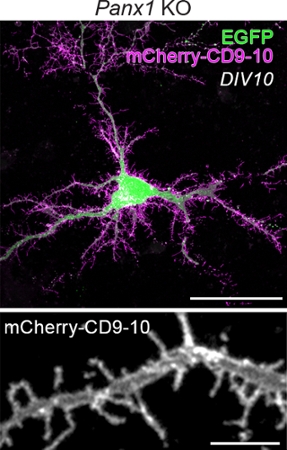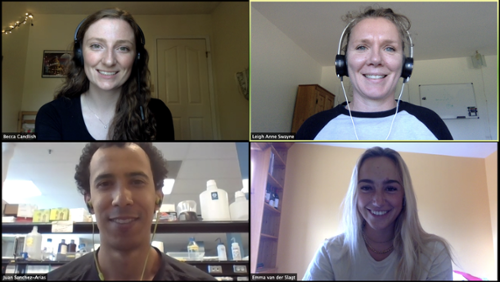Swayne lab uses innovative live cell microscopy to get a closer look at the development of nerve cell connections
In an innovative paper published this week in eNeuro, Swayne lab postdoctoral fellow Dr. Juan C. Sanchez-Arias offers new insights that could help us understand how the pannexin 1 (PANX1) channel protein regulates the formation of nerve cell connections, a key step in brain development.
 The goal of the study was to determine whether PANX1 affected the density of nerve cell connections by regulating their formation or stability. Sanchez-Arias focused his analysis on an earlier step in nerve cell development when “young” nerve cell projections called dendritic protrusions are most abundant. These dendritic protrusions reach out to probe their environments like microscopic fingers to eventually form connections with other nerve cells.
The goal of the study was to determine whether PANX1 affected the density of nerve cell connections by regulating their formation or stability. Sanchez-Arias focused his analysis on an earlier step in nerve cell development when “young” nerve cell projections called dendritic protrusions are most abundant. These dendritic protrusions reach out to probe their environments like microscopic fingers to eventually form connections with other nerve cells.
To measure the movement of dendritic protrusions in real-time, Sanchez-Arias used live cell confocal microscopy along with a novel approach that enhanced their detection. Research assistant Rebecca Candlish and undergraduate NSERC USRA summer research student Emma van der Slagt also made key contributions to supporting experimentation, analysis, and writing.
The team found that dendritic protrusion stability was inversely linked to the levels of the PANX1 protein. The protrusions were more dynamic when there was more PANX1 and more stable when there was less. This suggests that PANX1 regulates dendritic spine density in part through controlling their stability in the early stages of nerve cell connection formation.
The new paper expands on Sanchez-Arias’ recent discovery that the PANX1 protein regulates how many connections are made between nerve cells. PANX1 is a channel protein, meaning that it forms doorways in cell membranes. PANX1 channels – a major focus of Swayne lab research – transmit signals to tell the cell how to change in response to its environment. Sanchez-Arias recently completed his PhD thesis work with this research.
Again, you can click here to read “Pannexin 1 regulates dendritic protrusion dynamics in immature cortical neurons” by Juan C. Sanchez-Arias, Rebecca C. Candlish, Emma van der Slagt, and Leigh Anne Swayne in eNeuro.

Dr. Swayne is an Associate Professor in the University of Victoria Division of Medical Sciences and has an affiliate appointment at the UBC Dept of Cellular and Physiological Sciences through her involvement in the UBC Island Medical Program. She is also an active member of UBC’s Djavad Mowafaghian Centre for Brain Health.
Funding: This work was supported by operating grants from the Canadian Institutes of Health Research (MOP142215), from the Natural Sciences and Engineering Research Council (RGPIN-2017-03889), The Scottish Rite Charitable Foundation of Canada (15118) and the University of Victoria-Division of Medical Sciences to L.A.S. L.A.S. was also supported by a Michael Smith Foundation for Health Research and British Columbia Schizophrenia Society Foundation Scholar Award (5900). J.C.S.A. was supported by a University of Victoria Fellowship Graduate Award. L.A.S. is also grateful for infrastructure support from the Canada Foundation for Innovation (29462) and the BC Knowledge Development Fund (804754) for the Leica SP8 microscope system.
